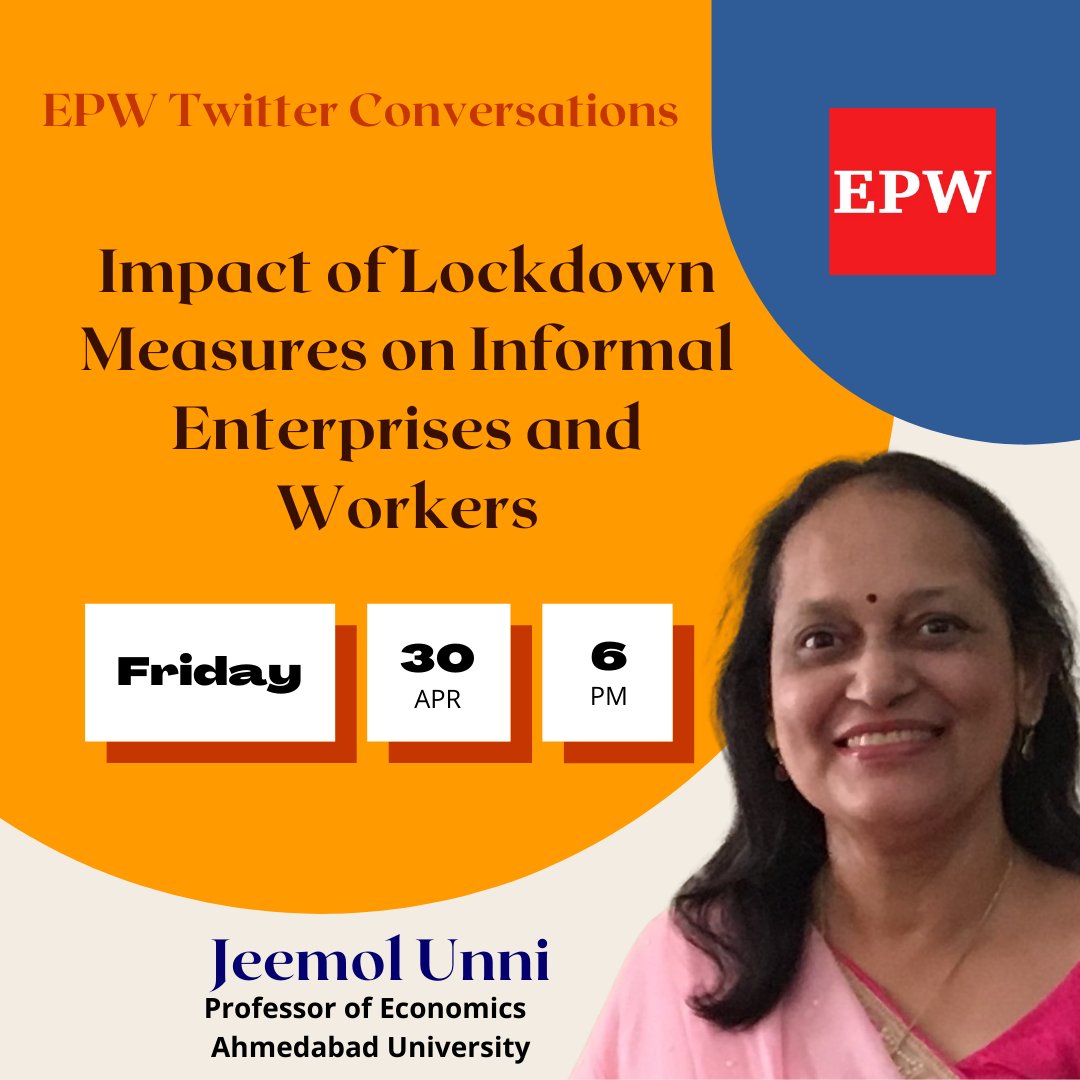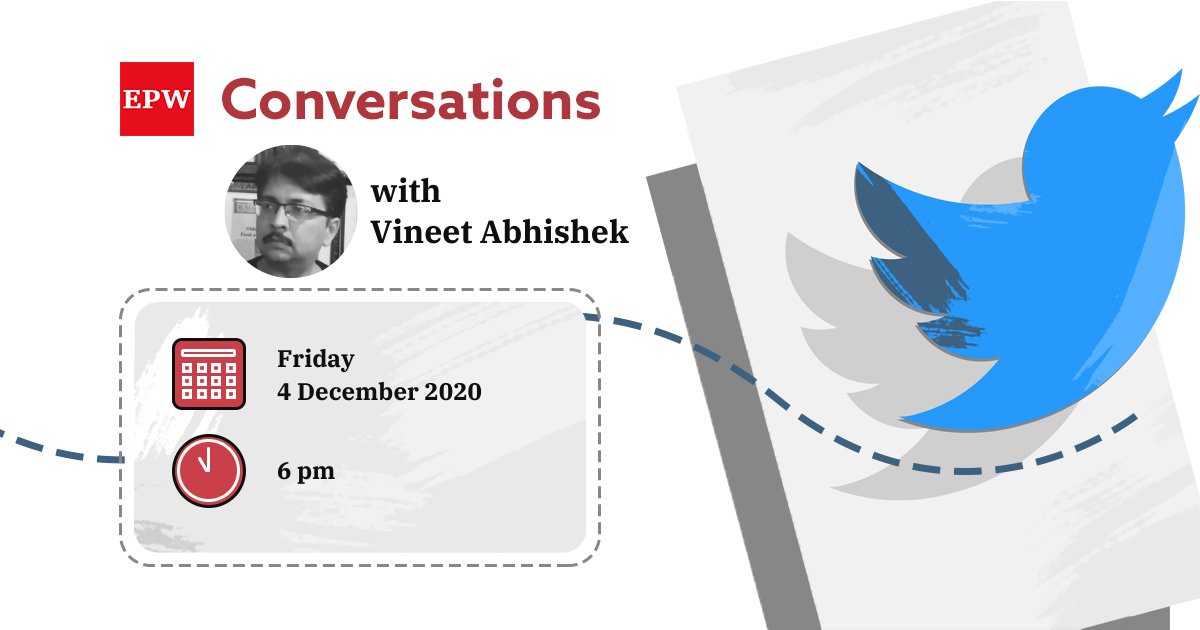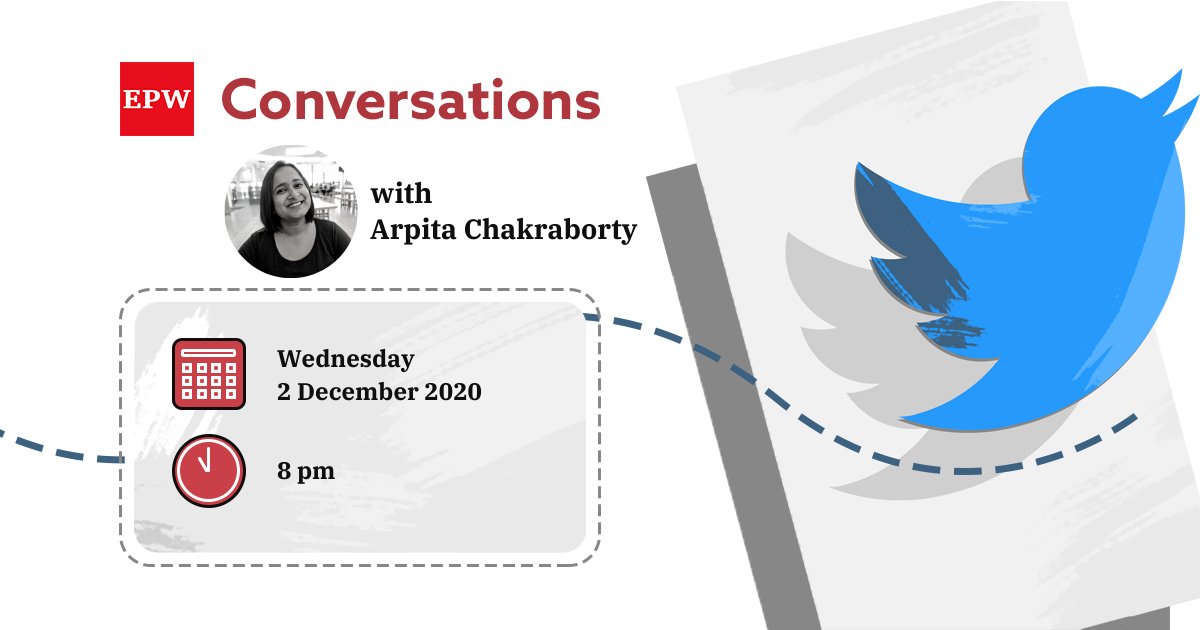
#EPWConversations
Did the #COVID19 lockdown relief measures help refigure the livelihoods of informal workers?
In this conversation #thread, professor @JeemolUnni
examines the impact of the lockdown on workers.
Join the discussion and send us your questions in the comments.
Did the #COVID19 lockdown relief measures help refigure the livelihoods of informal workers?
In this conversation #thread, professor @JeemolUnni
examines the impact of the lockdown on workers.
Join the discussion and send us your questions in the comments.

We are currently in the midst of the second wave of #COVID19 in India. People and the government are struggling with the public and private health system caving in.
The question before us for the second time in a year is to save lives and/or save livelihoods? | @JeemolUnni
The question before us for the second time in a year is to save lives and/or save livelihoods? | @JeemolUnni
The lockdown measure acted as a macroeconomic shock in 2020.
According to CMIE, an estimated 122 million people lost their jobs in April 2020 alone and three-quarters of these were small traders and wage labourers, mainly in the informal sector. | @JeemolUnni
According to CMIE, an estimated 122 million people lost their jobs in April 2020 alone and three-quarters of these were small traders and wage labourers, mainly in the informal sector. | @JeemolUnni
Researchers have observed a gendered impact on employment, with more women losing jobs and unable to join back after the lockdown (Patel, 2021 ). | @JeemolUnni
A gendered impact of another macroeconomic shock, demonetisation in 2016, was observed by us in another study (Unni and Dev, 2020 ). The impact of demonetisation also varied by states. | @JeemolUnni
It appeared that workers in Gujarat were better able to negotiate the shock of demonetisation.
However, there is no guarantee that the workers in Gujarat will be able to weather the shock of the pandemic lockdown and curfew as well as the earlier shock. | @JeemolUnni
However, there is no guarantee that the workers in Gujarat will be able to weather the shock of the pandemic lockdown and curfew as well as the earlier shock. | @JeemolUnni
As in the article, I am primarily concerned with the workers in the informal sector and within it, I focus on the more vulnerable segments: informal enterprises, construction workers, street vendors and domestic workers, migrant workers and the agricultural sector. | @JeemolUnni
India recorded 63 million MSME employing 107 million people, in 2018–2019 (GoI 2020).
About 72% were own account enterprises that did not hire workers on a regular basis and operated with their own family labour (Economic Census (EC), 2013).
epw.in/engage/article…
About 72% were own account enterprises that did not hire workers on a regular basis and operated with their own family labour (Economic Census (EC), 2013).
epw.in/engage/article…
Of the total enterprises nearly 36% were operated from household premises.
The small scale of operation of such micro-enterprise, own account and home based, makes them particularly vulnerable to an economic shock such as the lockdown (Unni, 2020). | @JeemolUnni
The small scale of operation of such micro-enterprise, own account and home based, makes them particularly vulnerable to an economic shock such as the lockdown (Unni, 2020). | @JeemolUnni
Professor @ProfVibhuti's article on EPW Engage also extensively discusses the impact of the pandemic on women, labour and the informal sector. | @JeemolUnni
epw.in/engage/article…
epw.in/engage/article…
The informal economy consists of approximately 411 million workers, estimated using the Periodic Labour Force Survey (PLFS), 2017–18 of the National Statistical Office (NSO).
At the link below, me and Pritha Dev discuss the macroeconomic shocks.
doi.org/10.1007/s40847…
At the link below, me and Pritha Dev discuss the macroeconomic shocks.
doi.org/10.1007/s40847…
The construction sector engages the second-largest component of informal workers, after the agricultural sector.
It constituted about 56 million workers, about 14.5% of male and 5.3% of female workers in 2017–18. | @JeemolUnni
It constituted about 56 million workers, about 14.5% of male and 5.3% of female workers in 2017–18. | @JeemolUnni
About 2% of all workers were street vendors, about 8 million in 2017–18.
Nearly 3% of women workers and 0.6% of men were engaged in domestic work with the proportion of women workers in domestic services in urban areas was larger at nearly 9% in 2017–18. | @JeemolUnni
Nearly 3% of women workers and 0.6% of men were engaged in domestic work with the proportion of women workers in domestic services in urban areas was larger at nearly 9% in 2017–18. | @JeemolUnni
Among enterprises, a distinction has to be made between self-employed own account micro-enterprises and establishments, small and medium enterprises.
Hence, these two categories of informal enterprises need to be considered separately. | @JeemolUnni
doi.org/10.1007/s41027…
Hence, these two categories of informal enterprises need to be considered separately. | @JeemolUnni
doi.org/10.1007/s41027…
The needs of the two are different and accordingly the measures to refigure livelihoods have to be different.
Further, different sectors of the MSME are likely to be unevenly impacted by the crisis. This may trigger large-scale restructuring of economic activities. @JeemolUnni
Further, different sectors of the MSME are likely to be unevenly impacted by the crisis. This may trigger large-scale restructuring of economic activities. @JeemolUnni
Refiguring Livelihood in MSME: Ministry of MSME needs to undertake a review of which industries are likely to collapse completely or partly (hospitality), and which are likely to zoom ahead (ecommerce). | @JeemolUnni
There is a need for a perspective plan or road map, perhaps from NITI Aayog, on this issue of restructuring. | @JeemolUnni
It would be helpful if the ministry could work out a road map of reallocation of informal (formal) labour towards less severely affected sectors or sectors where consumption demand might recover. | @JeemolUnni
This is, of course, easier said than done, as the skill sets required may be quite different in the various industries (Unni, IJLE, 2020). | @JeemolUnni
Other measures are to reduce operating costs, waivers or deferred payments for public services, such as electricity, water or rent, will greatly help the microenterprises. | @JeemolUnni
Further, subsidies in the form of reduced rates for mobile calls and internet access and training may enable micro units to experiment with digital tools for business continuity and income generation. | @JeemolUnni
My article with Pritha Dev and Akshaya Vijayalakshmi also discusses the impact and offers various mitigation strategies.
thehindubusinessline.com/opinion/impact…
thehindubusinessline.com/opinion/impact…
The construction sector can be revived relatively quickly maintaining #COVID19 precautions, provided its backward linkages (raw materials) are intact or revived. | @JeemolUnni
Fortunately, the Building and Construction Workers Act (BoCW) was enacted in 1996 to take care of the social security needs of construction workers. | @JeemolUnni
All construction workers are unfortunately not registered under the act.
There is a gap of 26 million workers who were not registered under the BoCW Act and therefore will not receive the direct benefit transfer. | @JeemolUnni
There is a gap of 26 million workers who were not registered under the BoCW Act and therefore will not receive the direct benefit transfer. | @JeemolUnni
Refiguring Livelihood in Construction: Registering workers under the BoCW Fund is a priority. It may be helpful to use local NGOs to identify such workers and help them in registering. Issues of migrant workers are also to be considered. | @JeemolUnni
Street Vendors: Street vendors are better off, partly because they are a visible and integral part of the trade sector of the country.
Demand is hit due to lack of money in circulation, and supply is impacted due to closure of units producing these commodities. | @JeemolUnn
Demand is hit due to lack of money in circulation, and supply is impacted due to closure of units producing these commodities. | @JeemolUnn
Domestic Workers: Domestic workers are the most invisible and consequently vulnerable group among the informal workers. They are faceless and voiceless.
This was clear as there was no space for them in the relief measures of the state. |@JeemolUnni
This was clear as there was no space for them in the relief measures of the state. |@JeemolUnni
The vulnerability of domestic workers was seen in the fact that the employers and resident associations/housing societies did not let them in, seeing them as a health risk. | @JeemolUnni
Other problems faced by domestic workers and other informal workers were not having enough ration, with only few workers receiving free ration and direct benefit transfers from the government. | @JeemolUnni
Many of these workers faced domestic violence while being confined at home, unable to contribute to household resources. | @JeemolUnni
A draft Domestic Workers policy is impending and needs urgent attention. The livelihoods of the domestic workers may be at risk even after the pandemic passes as the employers may not hire them back. | @JeemolUnni
We studied the effects of the lockdown on employment and living with the help of Ahmedabad based Saath Charitable Trust, in July 2020, which allowed us to capture the state of affairs during and after the lockdown. | @JeemolUnni
Among the informal workers, the average income loss has been higher for the self-employed than the wage-employed.
Our sample of self-employed workers with activities such as tailoring, beauty parlours, & food stalls were directly affected because of lockdown & social distancing.
Our sample of self-employed workers with activities such as tailoring, beauty parlours, & food stalls were directly affected because of lockdown & social distancing.
For the lockdown months of April and May, 42 per cent of our respondents reported having less ration than what they needed. Third of the respondents reporting insufficient ration for June even as the economy started opening up. | @JeemolUnni
We found that during the lockdown months, 70 per cent of the respondents received free ration from the government while only 14 per cent reported not receiving free ration from any source. | @JeemolUnni
The direct fallout of the lack of ration and help meant that many of our respondents did not have enough to eat, with two-thirds reporting that they ate less than before. | @JeemolUnni
The most critical issue today is loss of jobs and income due to low demand affecting both wage- and self-employed workers. The availability of adequate food is also a cause for worry. | @JeemolUnni
In the short term, some form of basic income must be provided monthly for low-income informal workers, mainly as many are not able to return to work or earn as before.
This is required immediately in the form of direct benefit transfer and must continue for the next six months.
This is required immediately in the form of direct benefit transfer and must continue for the next six months.
The most critical issue today is loss of jobs and income due to low demand affecting both wage- and self-employed workers. The availability of adequate food is also a cause for worry. | @JeemolUnni
In the short term, some form of basic income needs to be provided monthly for low-income informal workers, mainly as many are not able to return to work or earn as before. | @JeemolUnni
This is required to be done immediately in the form of direct benefit transfer and must continue for the next six months.
In the medium term, upgrading the skills of workers to engage them in related but higher-level occupations will give them more income and also reduce chance of dismissal. Here we find ourselves in shaky territory as there is no clear mapping of skill of workers.
Skill involves both formal certified skills and informal skills learnt on the job. To start small, one can identify many local-level efforts in cities that map skill of workers digitally (Unni, 2020, IJLE). | @JeemolUnni
There are many such initiatives in Bengaluru, Gurugram, Delhi, Ahmedabad and other cities. Recognizing and listing such organizations are a first step. | @JeemolUnni
The next step would be to compile a list of such informal workers and their skills from all these micro efforts. Once this process begins, many more such local initiatives will come to light. | @JeemolUnni
With mobile numbers of these workers, one can conduct a verification of their current location and updated skills. This could be major initiative towards visualizing a strategy for skilling and deploying these workers. | @JeemolUnni
The demand side of skill requirements of the industry located in industrial estates can also be digitalized. As a medium-term plan, national level mapping of demand and supply of skills can help to a large extend to identify the problem of skill mismatch. | @JeemolUnni
The next step would be to organize skill training for the eligible, classified by existing skills, in the areas where demand exists. | @JeemolUnni
In the long term problem of the digital divide has to be addressed. With much of commerce and services (including education) moving online, bridging the digital divide is required: (1) nation-wide internet connectivity, if not, rural areas and small towns will be left behind;
(2) to produce affordable smartphones, tablets and laptops, if not, women and young will be left behind; (3) affordable data charges and broadband, if not, the poor will be left behind. | @JeemolUnni
• • •
Missing some Tweet in this thread? You can try to
force a refresh








